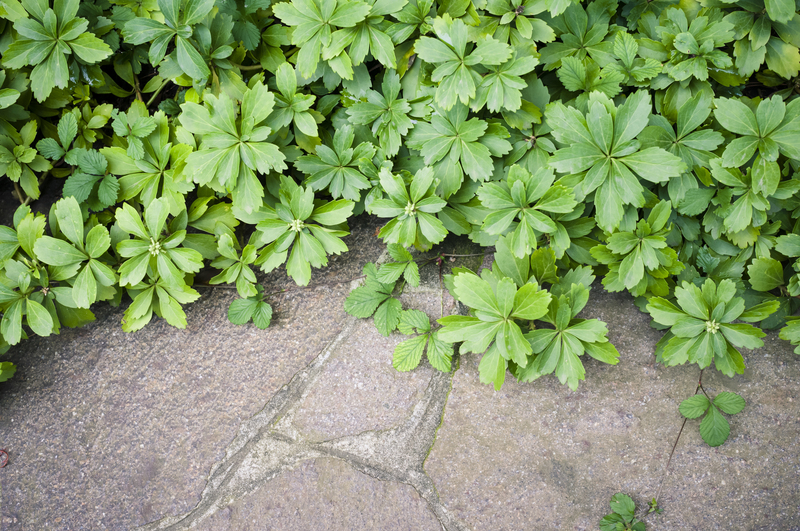Creative Solutions for Protecting Garden Plants in Cold Months
Posted on 30/08/2025
Creative Solutions for Protecting Garden Plants in Cold Months
When the days grow shorter and the chill sets in, dedicated gardeners face the annual challenge of keeping their plants alive and thriving through winter's harshest months. Whether you're tending to prized perennials, delicate bulbs, or useful vegetable crops, understanding protecting garden plants in cold months is essential for both plant survival and a beautiful garden year-round. In this comprehensive guide, we will explore a variety of innovative strategies, materials, and practices designed to shield your cherished greenery from freezing temperatures, biting winds, and unpredictable weather. By blending traditional wisdom with modern tips, you'll be equipped with all the creative solutions you need to safeguard your garden during winter.

Why Winter Protection Matters for Your Garden
Though many plants are dormant in winter, their roots and crowns remain vulnerable to frost heaving, hard freezes, desiccation from wind, and occasional thaws. Proper cold-weather plant protection ensures:
- Increased plant survival rates
- Vibrant spring growth and earlier blooms
- Reduced risk of fungal or pest infestations during winter stress
- Preservation of your time, labor, and financial investment
Gardening in cold months requires a strategic approach, combining knowledge of your local climate and the needs of individual plants. Creative solutions for winter plant protection offer more than just survival--they lay the groundwork for a flourishing garden come springtime.
Understanding Your Garden's Microclimate
To maximize your efforts in shielding garden plants from winter cold, first assess your property's microclimate. Consider:
- Wind exposure: Fences, buildings, and hedges may shelter some areas while others remain exposed.
- Sun patterns: Southern exposures typically receive more winter sunlight, aiding plant warmth.
- Low spots: Cold air and frost settle in depressions, increasing risk for plants in these areas.
- Soil drainage: Well-drained soil reduces root rot caused by winter moisture and freeze-thaw cycles.
Traditional Techniques: Time-Tested Cold Weather Practices
Mulching for Insulation
Mulch is one of the oldest and most effective ways to protect garden plants in cold months. Organic mulches--such as straw, shredded leaves, pine needles, or bark--create a thermal blanket that insulates soil and roots, preventing temperature fluctuations and frost heaving.
- Apply mulch after the first hard frost to trap soil warmth.
- Lay 2-4 inches around perennials, berries, and roses, but keep it away from direct contact with stems to reduce rot.
- For particularly sensitive plants, pile mulch higher and remove gradually in spring.
Row Covers and Cloches
Floating row covers made of spun-bonded fabric or lightweight blankets can be draped over vegetable beds and flower patches. They raise the temperature beneath and guard against frost.
- Secure edges with stones or garden staples to prevent wind displacement.
- Remove covers during sunny days to avoid overheating.
Glass or plastic cloches--miniature greenhouses--provide focused protection to individual plants. Recycled plastic bottles with the bottoms cut off also make handy DIY cloches for seedlings.
Innovative and Creative Plant Protection Methods
Upcycling Household Items for Winter Protection
*Gardeners can think outside the box!* Everyday household objects can serve as budget-friendly shields for protecting outdoor plants from cold weather:
- Blankets or old sheets: Drape lightly over shrubs or beds during frosty nights, but remove in the morning.
- Laundry baskets & buckets: Place over young veggies or herbs at sundown to guard against frost.
- Bubble wrap: Wrap around pots or containers to insulate roots, or build small tent structures for extra warmth.
- Cardboard boxes: Invert over smaller perennials or annuals during especially cold spells.
Creating Windbreaks and Shelters
Wind magnifies the effects of winter chill and dries out plant tissues. Building temporary windbreaks can significantly aid in cold month plant protection:
- Use stakes and burlap: Hammer wooden stakes around vulnerable plants; stretch burlap or frost fabric between them to deflect cold winds.
- Plant strategically: In future seasons, install evergreen shrubs or hedges to naturally shield exposed spots.
- Repurpose pallets: Old wooden pallets set upright make sturdy wind barriers in a pinch.
DIY Mini Greenhouses
For the serious cold-weather gardener, constructing small-scale greenhouses or cold frames is a game-changer for garden plant winter protection. Here's how to make an easy, affordable cold frame:
- Repurpose old window panes or clear acrylic panels.
- Build a simple frame from wood, bricks, or even hay bales.
- Set panels at an angle to maximize winter sunlight and allow for water runoff.
- Ventilate on warm days to prevent mold and overheating.
Watering Wisely Before Frost
Did you know moist soil retains heat better than dry soil? Watering sufficiently before an expected frost can help roots stay warmer.
- Soak soil during the day before freezing nights--avoid watering in the evening or in already frozen soil.
- Maintain consistent moisture for evergreens and container plants throughout winter.
Solar Methods and Heat Sources
Harnessing solar heat is a powerful technique for cold season plant protection:
- Water-filled jugs: Place dark-colored water jugs near plants; during the day, they absorb heat and at night release warmth, moderating nearby temperatures.
- Garden lights: Low-wattage outdoor bulbs or fairy lights generate just enough heat for delicate beds under row covers.
- Thermal blankets: Special horticultural blankets retain more heat than standard fabrics and are available at most garden centers.
Special Tips for Container Gardening in Winter
*Potted plants are uniquely susceptible to winter stresses--their roots lack the insulating buffer of surrounding earth.* Here are ways to extend cold protection to container garden plants:
- Group containers together in a sheltered location, such as against a south wall of your home or inside an unheated garage or shed.
- Elevate pots off the ground to prevent waterlogging and cracking from frozen water.
- Wrap pots with burlap, bubble wrap, or old towels for insulation.
- For especially tender plants, consider overwintering them inside or in a cool basement with sunlight.
Frost-Tolerant Plants: A Proactive Approach
While creative protection measures greatly boost winter survival, the heartiest defense is choosing cold hardy plants for winter gardens. Popular options for frosty climates include:
- Hellebores (Lenten Rose)
- Winter pansies and violas
- Evergreen ferns
- Boxwood and holly shrubs
- Chives, kale, and spinach for edibles
Protecting Garden Plants in Cold Months: Common Mistakes to Avoid
- Over-mulching: Thick, heavy mulches applied too early can encourage rot or pest infestations.
- Neglecting ventilation: Overcovering with no air circulation fosters moisture buildup and disease.
- Delaying protection measures: Wait for plants to go dormant and use materials only when hard frost is imminent.
- Ignoring the weather: Cold snaps can occur even after a warm spell--stay vigilant and adjust protection accordingly.
- Forgetting about water: Drought in winter is real, especially for evergreens; check soil moisture on warmer days.
Preparing for Spring After the Freeze
As winter winds down, slowly remove protective materials once danger of hard frost has passed. Gradual exposure allows plants to acclimate to fluctuating conditions. Inspect for signs of rot, fungal growth, or pest activity, and prune winter-damaged sections as needed.
Start light fertilizing and resume regular watering to stimulate new growth. A careful transition ensures your garden plants not only survive the cold months but also emerge lush and vibrant in spring.

FAQs About Protecting Garden Plants in Cold Months
What is the best mulch to use for winter protection?
Organic materials like shredded leaves, straw, pine needles, and composted bark provide excellent insulation and break down beneficially over time.
Can I leave row covers on all winter?
Only if they are breathable and occasional access is given for watering and air exchange. Remove during warm, sunny spells to prevent overheating.
Is snow helpful or harmful to garden plants?
*Snow can actually be an excellent insulator*, protecting plants from cold air. However, heavy accumulations should be gently brushed off branches to prevent breakage.
How can I protect sensitive potted plants during winter?
Group containers in sheltered spots, add insulation around pots, and consider moving tender species indoors if possible.
Conclusion: Embrace Creativity For Winter Gardening Success
The cold season need not spell doom for your beloved plants. By combining traditional methods, household ingenuity, and proactive planning, you can effectively protect your garden plants during the cold months while sowing the seeds for future beauty and bounty. Mulch generously, construct clever shelters, upcycle household items, and choose cold-hardy varieties to make your garden a winter wonderland of resilience and promise. With these creative solutions for winter plant protection, you will look forward to spring with confidence, knowing that your efforts have kept the heart of your garden warm, even in the depths of winter.

